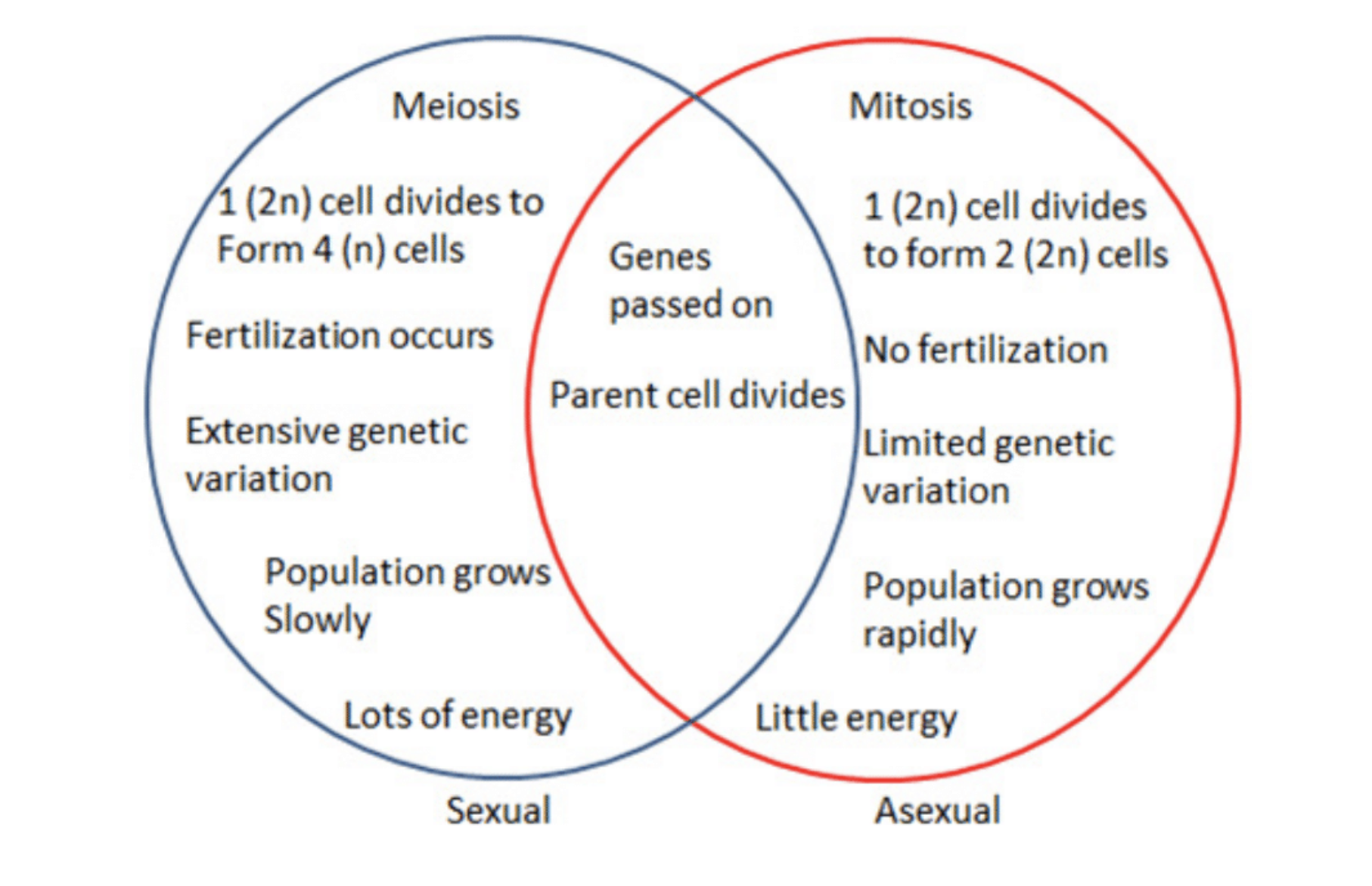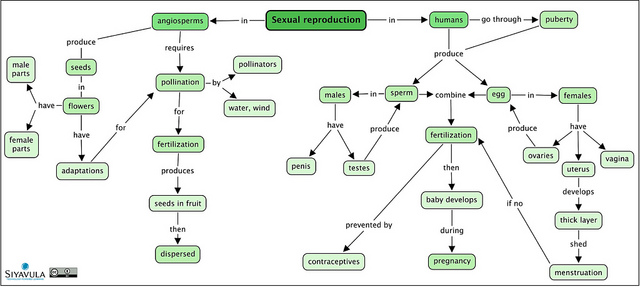Difference Between Sexual and Asexual Reproduction
Sexual reproduction is reproduction involves fertilization to form an embryo. Asexual reproduction involves in cell division without fertilization.
What is Sexual Reproduction?
Definition of Sexual Reproduction:
Sexual reproduction is the type of reproduction in which sex cells are produced and come together during fertilization to form an embryo.
Type of Cell Division:
The type of cell division that is involved is called meiosis and results in four cells being formed from one parent cell. All cells formed are genetically unique and have half the number of chromosomes, that is, are haploid (n) compared with the parent cell which is diploid (2n).
The Process:
Genetic variation is introduced during the first stages of meiosis by crossing over of chromosomes and independent assortment. A cell also divides to form four cells which become sex cells known as gametes. Gametes then fuse during random fertilization.
Advantages:
The big advantage of sexual reproduction is that genetic variation is introduced in three ways during the cell division and fusion of gametes. This is an advantage because it means that some individuals will be able to survive and reproduce. That is there is enough genetic variation for natural selection to occur and individuals to be selected for.
Disadvantages:
Sexual reproduction can be more costly than asexual reproduction. For one thing, animals often need to invest a lot of time and energy in finding a mate and courting a mate. A male bird for example often has elaborate singing and courtship displays that are designed to attract a female. These displays though make males more likely to be seen by a predator, so there is a cost involved. More energy and time is involved in sexual reproduction since offspring can’t be produced unless you have male and female gametes coming together.
Examples:
Most plants and animals have sexual reproduction, as well as some protists.

Venn Diagram of Sexual and Asexual Reproduction
What is Asexual Reproduction?
Definition of Asexual Reproduction:
Asexual reproduction is the type of reproduction in which one cell divides to form two cells. There is no formation of sex cells or fusion of cells involved.
Type of Cell Division:
The type of cell division that is involved is called mitosis and results in two cells being formed from one parent cell. All cells formed are genetically identical to the parent cell and have the same number of chromosomes, that is are diploid (2n), as the parent cell.
The Process:
A cell divides into two during mitosis and genetic variation is not introduced by methods evident during meiosis. A little bit of variation is sometimes introduced through random mutations. The process is simple and does not require two individuals.
Advantages:
There are some benefits to asexual reproduction. On the one hand, you do not have to find a mate, so this saves a lot of time and energy. No courting is needed and a cell simply undergoes mitotic division. Because of the saving in time, a population can divide very quickly and grow very quickly as a result.
Disadvantages:
The main drawback is that genetic variation is limited. Some genetic variation can be introduced by genetic mutation, but this may be limited. This means that an entire population can be eliminated if there is some natural disaster since there may be no individuals able to survive.
Examples:
Bacteria commonly undergo asexual reproduction, as do many protists.
Difference between Sexual and Asexual Reproduction?
-
Definition
Sexual reproduction is reproduction where sex cells are formed which come together and fuse during fertilization to form an embryo. Asexual reproduction is reproduction where one cell divides into two cells, and no fertilization of cells occurs.
-
Type of cell division
Meiosis is the cell division that occurs in sexual reproduction. It results in four haploid cells being formed from one diploid cell diving twice. Mitosis is the cell division that occurs in asexual reproduction. It results in two diploid cells being formed from one diploid cell dividing once.
-
Genetic variation
High levels of variation are introduced during the meiosis and fertilization of sexual reproduction. Very low levels of variation can be introduced during mitosis due to random genetic mutations.
-
Population growth rate
Organisms that have sexual reproduction have a slower population growth rate and organisms that have asexual reproduction have a faster population growth rate.
-
Time involved
Sexual reproduction takes a lot of time because a partner has to be found and the cell has to divide twice. Asexual reproduction does not take much time because a partner is not needed and the cell only divides once.
-
Energy involved
Sexual reproduction uses a lot of energy because a partner has to be found, and in some animals, an elaborate courtship is needed which is energetically costly. Asexual reproduction uses very little energy because a partner is not needed and the cell simply divides.
-
Examples
Sexual reproduction is most commonly found in plants, animals, fungi and some protists. Asexual reproduction is most commonly found in bacteria and some protists.
Table comparing Sexual and Asexual Reproduction
Summary of Sexual Vs. Asexual Reproduction
- Sexual and asexual reproduction both involve a cell dividing and the transfer of genetic information into new cells.
- Both types of reproduction can produce new organisms that themselves can reproduce.
- Sexual reproduction involves a lot of genetic variation being introduced during meiosis and during fertilization
- Asexual reproduction has limited genetic variation or none depending on if a mutation occurs during mitosis.
- There are advantages and disadvantages to both asexual and sexual reproduction.
- Difference Between Rumination and Regurgitation - June 13, 2024
- Difference Between Pyelectasis and Hydronephrosis - June 4, 2024
- Difference Between Cellulitis and Erysipelas - June 1, 2024
Search DifferenceBetween.net :
1 Comment
Leave a Response
References :
[0]Barton, Nicholas H., and Brian Charlesworth. "Why sex and recombination?" Science 281.5385 (1998): 1986-1990.
[1]Cook, Robert Edward. "Asexual reproduction: a further consideration." The American Naturalist 113.5 (1979): 769-772.
[2]Smith, Neal Griffith. “Reproductive behaviour”. Science, Encylopaedia Britannica, 2018, https://www.britannica.com/science/reproductive-behaviour-zoology
[3]Image credit: https://www.flickr.com/photos/121935927@N06/13537113433
[4]Image credit: https://upload.wikimedia.org/wikipedia/commons/thumb/a/a0/Asexual_reproduction_moss_svg_diagram_nolabels.svg/500px-Asexual_reproduction_moss_svg_diagram_nolabels.svg.png



Am satisfied with answers